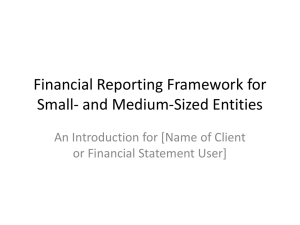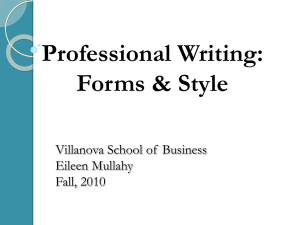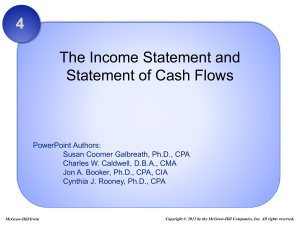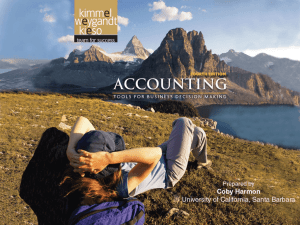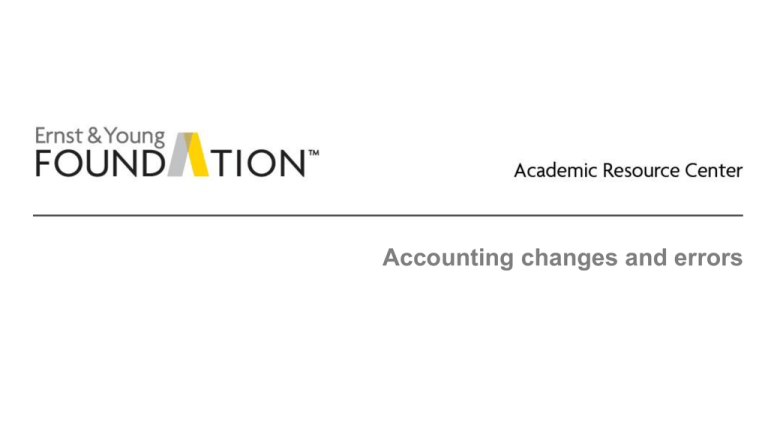
Accounting changes and errors
Typical coverage of US GAAP
►
►
►
►
►
►
Adoption of a new accounting standard
Change in accounting policy
Change in accounting estimate
Correction of errors
Change in reporting entity
Disclosures
Accounting changes and errors
Academic Resource Center
Page 2
Executive summary
►
Both IFRS and US GAAP have similar recognition treatment for accounting changes, changes
in estimates and corrections of errors. The required disclosures are also similar.
►
IFRS provides an exception if it is impractical to restate financial statements for a correction of
an error. US GAAP requires all material errors to be corrected by restating, and does not
provide an impractical exception.
Accounting changes and errors
Academic Resource Center
Page 3
Primary pronouncements
US GAAP
►
IFRS
ASC 250, Accounting Changes and Error
Corrections
►
IAS 8, Accounting Policies, Changes in
Accounting Estimates and Errors
Accounting changes and errors
Academic Resource Center
Page 4
Progress on convergence
►
There is no convergence activity planned at this time.
Accounting changes and errors
Academic Resource Center
Page 5
Adoption of a new accounting standard
US GAAP
IFRS
Upon adoption of a new accounting standard,
the transition guidance in the standard, if any,
should be followed. If no guidance is provided,
then the new accounting standard should be
applied retrospectively, when practical.
Accounting changes and errors
Academic Resource Center
Similar
Page 6
Change in accounting policy
US GAAP
IFRS
A change in accounting policy is defined as a
change from one generally accepted
accounting principle to another generally
accepted accounting principle. If practical, the
change should be applied retrospectively.
Similar
The initial adoption of an accounting principle
for new events or to account for items that were
previously immaterial is not considered a
change in accounting.
Similar
Accounting changes and errors
Academic Resource Center
Page 7
Change in accounting policy
US GAAP
IFRS
ASC 250-10-45-6, when it is impracticable “to
determine the period-specific effects of that change
on all prior periods presented, the cumulative effect
of the change to the new accounting principle shall
be applied to the carrying amounts of assets and
liabilities as of the beginning of the earliest period to
which the new accounting principle can be applied.
An offsetting adjustment, if any, shall be made to the
opening balance of retained earnings (or other
appropriate components of equity or net assets in
the statement of financial position) for that period.”
Accounting changes and errors
Academic Resource Center
Similar: Per IAS 8, paragraph 25,
“when it is impracticable to
determine the cumulative effect, at
the beginning of the current period,
of applying a new accounting policy
to all prior periods, the entity shall
adjust the comparative information to
apply the new accounting policy
prospectively from the earliest date
practicable.”
Page 8
Retrospective application of a change in accounting
principle example
Example 1
Toy Company management decides to adopt the FIFO method of inventory valuation at the beginning of
2012. Toy Company had used the average cost method for its inventory valuation since its inception on
January 1, 2010. Toy Company’s accounting records are sufficient to apply the FIFO method
retrospectively. Toy Company’s management concluded that the FIFO method of inventory valuation is
preferable because it results in a better match of costs and revenues. The change in accounting principle
will be reported through retrospective application. Toy Company’s effective income
tax rate is 30%. In 2012, sales were $3,200 and selling, general and administrative
expenses were $1,200.
The effects of the change in inventory and cost of sales, Toy Company’s statement of
income and statement of retained earnings are presented on the following slides.
►
Prepare Toy Company’s statements of income and retained earnings for 2011
and 2012 reflecting retrospective application of the accounting change. Note
that the solution will be the same under US GAAP and IFRS.
Accounting changes and errors
Academic Resource Center
Page 9
Retrospective application of a change in accounting
principle example
The effects of the change in accounting principle on inventory and the cost of sales are presented in
the following table.
Inventory determined by:
Average method
–
FIFO method
$
–
Cost of sales determined by:
Average
FIFO method
method
December 31, 2010
$100
$ 80
$ 800
$ 820
December 31, 2011
$200
$260
$1,000
$ 940
December 31, 2012
$320
$350
$1,130
$1,100
Academic Resource Center
$
–
$
Accounting changes and errors
$
–
January 1, 2010
Page 10
Retrospective application of a change in accounting
principle example
Toy Company’s statement of income, as originally reported under the average cost method, is
presented below.
Toy Company
Statement of income
(As previously reported before the change in accounting policy)
2011
2010
$3,000
$3,000
Cost of goods sold
1,000
800
Selling, general and administrative expenses
1,000
1,000
Income before income taxes
Income taxes
1,000
300
1,200
360
$ 700
$ 840
Sales
Net income
Accounting changes and errors
Academic Resource Center
Page 11
Retrospective application of a change in accounting
principle example
Toy Company
Statement of retained earnings
(As previously reported before the change in accounting policy)
Beginning retained earnings
Net income
Ending retained earnings
Accounting changes and errors
Academic Resource Center
2011
2010
$ 840
$ –
700
840
$1,540
$840
Page 12
Retrospective application of a change in accounting
principle example
Example 1 solution: Toy Company’s statements of income and retained earnings, reflecting the
retrospective application of the accounting change from the average cost method to the FIFO
method, are presented below and on the next slide.
Toy Company
Statement of income
2012
Sales
$3,200
Cost of goods sold
Selling, general and administrative expenses
Income before income taxes
Income taxes
Net income
Accounting changes and errors
Academic Resource Center
2011 as
adjusted
$3,000
1,100
940
1,200
900
270
$ 630
1,000
1,060
318
$ 742
Page 13
Retrospective application of a change in accounting
principle example
Example 1 solution (continued):
Toy Company
Statement of retained earnings
Beginning retained earnings as reported
Cumulative effect of change in accounting*
Beginning retained earnings as restated
Net income**
Ending retained earnings
2012
2011, as
adjusted
$1,568
$ 840
–
(14)
–
826
630
742
$2,198
$1,568
*Calculated as the change in the cost of sales for 2010, net of tax (($800 - $820) x 70%)
**Net income for 2011 was originally reported as $700. The new accounting method for inventory decreased the cost
of goods sold by $60 and increased net income by $42.
Accounting changes and errors
Academic Resource Center
Page 14
Prospective application of a change in accounting principle
example
Example 2: During 2011, Cooper Company, Inc.’s (CCI) management installed a new
computerized inventory accounting system. CCI reports under US GAAP. The new system
allows management for the first time to determine the specific costs for each product in the 2011
ending inventory, but not for any date prior to the 2011 year-end. CCI turns its entire inventory
three times a year. There were no lower-of-cost-or-market issues with inventory in 2010 or 2011.
CCI’s effective income tax rate is 50%. CCI has had 2.0 million shares of common stock
outstanding since its inception in 2009. Management decided to change its accounting policy for
inventory costing from FIFO to the specific-identification method in 2011. Management believes
this change will better match costs and revenues and is, therefore, a preferable change.
Additional information is shown on the next slide. In 2010, CCI’s
accounting policy for inventory was as follows: inventory is stated
at the lower of cost, FIFO or market.
►
Assess how CCI would report this change in accounting
principle under US GAAP. List any significant differences
between US GAAP and IFRS.
Accounting changes and errors
Academic Resource Center
Page 15
Prospective application of a change in accounting principle
example
Additional information (amounts in millions):
2010
2011
$ 10
$ 11
NA
$ 13
Cost of sales using FIFO
$ 30
$ 33
Cost of sales using specific identification
Retained earnings using FIFO
Retained earnings using specific identification
NA
$110
NA
$ 31
$120
NA
Year-end inventory value using FIFO
Year-end inventory value using specific identification
Note: NA indicates the information in not available.
Accounting changes and errors
Academic Resource Center
Page 16
Prospective application of a change in accounting principle
example
Example 2 solution:
Management cannot apply the new inventory accounting policy to the inventory balance at the end
of 2010, nor to the beginning inventory balance in 2011, because the system needed to make the
determination of specific identification of costs did not exist at that time. Therefore, neither the 2010
ending retained earnings balance nor the 2011 beginning retained earnings would be restated. The
earliest date at which the change in accounting policy can be reflected is on the 2011 year-end
balance sheet. The impact of the change is to decrease cost of sales by $2.0 million. The after-tax
impact on the 2011 year-end financial information would be to increase net income and retained
earnings by $1.0 million.
There are no significant differences between US GAAP and IFRS.
Accounting changes and errors
Academic Resource Center
Page 17
Changes in accounting estimates
US GAAP
IFRS
A change in estimate due to new developments
or new information should be accounted for in
the period of the change or in future periods,
depending on the periods impacted by the
change (i.e., the change should be accounted
for prospectively).
Similar
A change in depreciation methodology on
existing assets is treated as a change in
estimate.
Similar
Accounting changes and errors
Academic Resource Center
Page 18
Correction of errors
US GAAP
IFRS
Generally requires that material, prior-period
errors be corrected retrospectively by restating
all prior reported accounts impacted by the
error and recording a prior-period adjustment to
the beginning retained earnings balance.
Accounting changes and errors
Academic Resource Center
Similar
Page 19
Correction of errors
US GAAP
►
IFRS
All material errors should be corrected by
restatement.
►
IFRS provides an exception if it is
impractical. IFRS narrowly defines
impractical in IAS 8, paragraph 5, as
follows:
“Applying a requirement is impractical
when an entity cannot apply it after making
every reasonable effort to do so.”
Accounting changes and errors
Academic Resource Center
Page 20
Correction of errors
US GAAP
►
IFRS
All material errors should be corrected by
restatement.
►
Definition of impractical (continued): “For
a particular prior period, it is impractical to
apply a change in accounting policy
retrospectively or to make a retrospective
restatement to correct an error if:
►
“(a) The effects of the retrospective
application or retrospective restatement are
not determinable;
►
“(b) The retrospective application or
retrospective restatement requires
assumptions about what management’s
intent would have been in that period; or
Accounting changes and errors
Academic Resource Center
Page 21
Correction of errors
US GAAP
►
IFRS
All material errors should be corrected by
restatement.
►
Definition of impractical (continued):
►
“(c) The retrospective application or
retrospective restatement requires significant
estimates of amounts and it is impossible to
distinguish objectively information about the
estimates that:
►
“(i) provides evidence of circumstances that
existed on the date(s) at which those
amounts are to be recognized, measured, or
disclosed; and
►
“(ii) would have been available when the
financial statements for that prior period were
authorized for issue, from other information.”
Accounting changes and errors
Academic Resource Center
Page 22
Correction of errors
US GAAP
►
IFRS
All material errors should be corrected by
restatement.
►
IAS 8, paragraphs 44 and 45, provide
guidance when it is impractical to correct
an error by retrospective restatement. The
opening balances should be restated for
the earliest period possible. The standard
notes restatement may be limited in some
cases to the current period.
Accounting changes and errors
Academic Resource Center
Page 23
Correction of an error example
Example 3
When preparing a comparative analysis of income tax expense in 2011, the Modern Art
Company (MAC) discovered that the 2010 calculation did not include foreign income
taxes of $2.0 million. Management determined this error is material and that the financial
statements need to be corrected. MAC reports under US GAAP. Additional information
is on the following slide.
► Determine
how MAC should report the correction of
this error in the balances shown above. List any
significant differences between US GAAP and IFRS.
Accounting changes and errors
Academic Resource Center
Page 24
Correction of an error example
Example 3 (continued): Extracts from the statements of income and retained earnings, before
correcting the error, are as follows (amounts in millions):
2011
Net income before income taxes
$20
$14
8
5
Net income
$12
$ 9
Beginning retained earnings
$52
$50
12
9
Dividends paid
(10)
(7)
Ending retained earnings
$54
Income taxes
Net income
Accounting changes and errors
Academic Resource Center
2010
$52
Page 25
Correction of an error example
Example 3 solution:
2011
Net income before income taxes
Restated
2010
$20
$ 14
8
7
Net income
$12
$ 7
Beginning retained earnings
$50
$50
12
7
Dividends paid
(10)
(7)
Ending retained earnings
$52
Income taxes
Net income
$50
There are no significant differences between US GAAP and IFRS.
Accounting changes and errors
Academic Resource Center
Page 26
Correction of an error example
Example 4
The ABC Company (ABC) has been valuing its inventory using FIFO since its inception on January 1, 2010.
All inventory calculations were done manually until December 31, 2012, when a new, computerized costing
system was fully implemented. The controller compared the closing inventory value at December 31, 2011,
which had been calculated manually, and the opening inventory value on January 1, 2012, which had been
calculated using the new computerized costing system, and noted the inventory was overstated by
$2.0 million. Management doubled-checked the new inventory costing program and determined the
computer program was valuing inventory properly. Management determined this error is material and that
the financial statements need to be corrected. After some research of the manual inventory records for 2011
and 2010, management concluded it was impractical to determine if the error in valuing the inventory
occurred in 2011 or 2010, or in both years. ABC has incurred losses since its inception and has not paid any
income taxes. Additional information is shown on the following slide.
Determine how ABC should report the correction of this error in the
balances shown above.
► List any significant differences between US GAAP and IFRS.
►
Accounting changes and errors
Academic Resource Center
Page 27
Correction of an error example
Example 4 (continued): Extracts from the statement of operations and statement of retained
deficit, before correcting the error, are as follows (amounts in millions):
2011
Revenue
$ 30
$10
Cost of sales
20
9
Selling and administrative cost
12
10
Net loss
$ (2)
$ (9)
Beginning retained deficit
$ (9)
$ –
Net loss
Ending retained deficit
Accounting changes and errors
Academic Resource Center
2010
(2)
(9)
$(11)
$ (9)
Page 28
Correction of an error example
Example 4 solution:
US GAAP does not provide an impractical
exception, but instead requires the error to be
corrected in the period it arose. Additional work
needs to be done to determine the impact of the
correction of the error on the 2010 and 2011
financial information.
IFRS provides an impractical exception for
correcting an error. When it is impractical to
determine the period in which the error arose, the
earliest period for which a determination can be
made should be restated. In this example, the
ending balance of the December 31, 2011,
inventory should be reduced by $2.0 million and
the cost of sales should be increased by
$2.0 million in 2011.
Revenue
Cost of sales
Selling and administrative
cost
12
12
Net loss
$ (2)
$ ( 4)
Beginning retained deficit
Net loss
$ ( 9)
(2)
$ ( 9)
(4)
Ending retained deficit
$(11)
$(13)
Accounting changes and errors
Academic Resource Center
2011
$ 30
20
Restated
2011
$ 30
22
Page 29
Change in reporting entity
US GAAP
IFRS
US GAAP requires revised financial statements for
the new entity for all reporting periods presented.
Per Ernst & Young’s International GAAP 2012,
Chapter 3, section 4.1.4: “a significant acquisition
or disposal, or a review of the presentation of the
financial statements might suggest … An entity
should change the presentation of its financial
statements only if the changed presentation
provides information that is reliable and is more
relevant to the users of the financial statements and
the revised structure is likely to continue, so that
comparability is not impaired. When making such
changes in presentation, an entity will need to
reclassify its comparative information … .”
Accounting changes and errors
Academic Resource Center
Similar
Page 30
Change in reporting entity
US GAAP
►
Provides for combined financial
statements.
IFRS
►
Does not provide for combined financial
statements. Therefore, a change in
reporting entity under ASC 250-10, for
example, for entities under common
control, would not be allowed under IFRS
except under very rare circumstances
involving the use of IAS 1 True and Fair
Override.
Accounting changes and errors
Academic Resource Center
Page 31
Disclosures
Change in accounting principle
US GAAP
IFRS
If the change is due to new accounting
guidance, that guidance should be identified.
Similar – a description of how the
change provides more reliable
and relevant information is
required. See next slide for
details.
An explanation of why the change in
accounting is preferable.
The method of applying the change, which is
generally the retrospective application to the
earliest period presented.
Accounting changes and errors
Academic Resource Center
Similar
Similar
Page 32
Disclosures
Change in accounting principle
US GAAP
Requires disclosure of why the new accounting
principle is preferable. However, virtually no
guidance for evaluating the reasonableness of
management’s justification for a voluntary change in
accounting principle is provided. One of the few
examples, ASC 330-10-30-14, discussing methods
of costing inventory, offers some general guidance
on preferability, as follows: “Although selection of
the method should be made on the basis of the
individual circumstances, financial statements will
be more useful if uniform methods of inventory
pricing are adopted by all companies within a given
industry.”
IFRS
Accounting changes and errors
Academic Resource Center
Page 33
Disclosures
Change in accounting principle
US GAAP
►
IFRS
Further, ASC 250-10-55-1 states “...
preferability among accounting principles
shall be determined on the basis of
whether the new principle constitutes an
improvement in financial reporting and not
on the basis of the income tax effect
alone.” Matters to consider in assessing
preferability would include authoritative
support, the rationale for change
(conformity with broad concepts of
accounting, better matching of costs and
revenue) and industry practice.
►
Requires disclosure of why the new
accounting policy provides more relevant
and reliable information. IFRS contains no
guidance on how to assess whether or not
a change in accounting policy is a “more
relevant” policy. Matters to consider when
assessing relevance would include
industry practice, whether the policy is
widely recognized and prevalent in
practice and whether the change will result
in more useful information.
Accounting changes and errors
Academic Resource Center
Page 34
Disclosures
Change in accounting principle
US GAAP
IFRS
►
Conceptually, there is no significant
difference between US GAAP and IFRS.
However, subtle differences arising from
the interpretation of preferable versus
relevant and reliable could result in
different conclusions on the
appropriateness of the change in
accounting.
Accounting changes and errors
Academic Resource Center
Page 35
Disclosures
Change in accounting principle
US GAAP
The amount of the adjustment relating to periods
before those included in the financial statements.
Generally, this is to the beginning retained earnings
for the earliest year presented in the financial
statements. In US GAAP, this is referred to as the
cumulative effect of the change in accounting policy
adjustment.
The impact of the change on the affected financial
statement line items.
If retrospective application of the new accounting
policy is not practical, a disclosure must be provided
that explains why this is the case and which periods
have been restated
Accounting changes and errors
Academic Resource Center
IFRS
Similar
Similar
Similar
Page 36
Prospective application of a change in accounting principle
disclosure example
Example 5
►
►
Using the information from the example beginning on slide 15, draft CCI’s accounting policy
footnote for inventory as it should appear in the comparative 2010 and 2011 financial
statements.
List any significant differences between US GAAP and IFRS.
Accounting changes and errors
Academic Resource Center
Page 37
Prospective application of a change in accounting principle
example
Example 5 solution:
In 2010, inventory is stated at the lower of cost, FIFO or market. During 2011, management
installed a new, computerized inventory accounting system that allowed management for the first
time to determine the specific costs for each product in the 2011 ending inventory. Effective with the
2011 year-end, CCI began valuing its inventory at the lower of the specific cost or market. CCI’s
management believes that the specific-identification method results in a better match of costs and
revenues. The cumulative effect of this change on retained earnings at the beginning of 2011 is not
determinable, nor are the pro forma effects of retroactive application of the specific-identification
inventory costing method to prior years. If the specific-identification method of valuing inventory had
not been used in 2011, the inventory value would have been reduced by $2.0 million. The effect of
this change on the 2011 results was to increase net income by $1.0 million, which is also the
cumulative effect on retained earnings at the end of 2011, or 50 cents per common share.
There are no significant differences between US GAAP and IFRS.
Accounting changes and errors
Academic Resource Center
Page 38
Disclosures
Change in accounting estimates
US GAAP
IFRS
Generally, no separate disclosure of changes in
estimates is required unless the change is
viewed as material to understanding the current
year’s financial statements or the impact on
future periods is expected to be material.
Accounting changes and errors
Academic Resource Center
Similar
Page 39
Disclosures
Correction of errors
US GAAP
IFRS
The nature of the error and the periods
affected.
Similar
The impact on each financial statement line
item restated, including the impact on earnings
per share, if applicable.
Similar
The cumulative impact of the restatement on
the earliest year restated.
Similar
Accounting changes and errors
Academic Resource Center
Page 40
Disclosures
Correction of errors
US GAAP
►
IFRS
Requires restatement to correct an error.
►
Provides an impractical exception to a
restatement for correcting an error. If a
company uses the impractical exception, it
should disclose why it is impractical to
restate and how and for which period the
error has been corrected.
Accounting changes and errors
Academic Resource Center
Page 41
Correction of an error disclosure
Example 6
►
Using the information from the example beginning on slide 24, draft MAC’s required financial
statement disclosures related to the correction of this error.
►
List any significant differences between US GAAP and IFRS.
Accounting changes and errors
Academic Resource Center
Page 42
Correction of an error example
Example 6 solution:
MAC failed to record foreign income expenses of $2.0 million in 2010. The financial statements
for 2010 have been restated as follows to correct this error (amounts in millions):
Net income before income taxes
Income taxes
As reported 2010
$14
(5)
Correction of error
$ –
(2)
Restated 2010
$14
(7)
Net income
$ 9
$ (2)
$ 7
Beginning retained earnings
Net income
Dividends paid
$50
9
(7)
$ –
(2)
–
$50
7
(7)
Ending retained earnings
$52
$ (2)
$50
There are no significant differences between US GAAP and IFRS.
Accounting changes and errors
Academic Resource Center
Page 43
Correction of an error disclosure
Example 7
►
Using the information from the example beginning on slide 29, draft ABC’s required financial
statement disclosures related to the correction of this error.
►
List any significant differences between US GAAP and IFRS.
Accounting changes and errors
Academic Resource Center
Page 44
Correction of an error disclosure
Example 7 solution:
US GAAP:
A disclosure regarding the correction of the error should be prepared once ABC has identified the
impact on each of the years reported.
IFRS:
ABC implemented a new computerized costing system in 2012, which resulted in a determination
that the December 31, 2011, ending inventory was overstated by $ 2.0 million. After some research
of the manual inventory records for 2011 and 2010, management concluded that it was impractical
to determine if the error in valuing inventory occurred in 2011 or 2010, or in both years. Therefore,
the earliest point at which the correction of the error could be recorded was December 31, 2011.
Accounting changes and errors
Academic Resource Center
Page 45
Ernst & Young LLP
Assurance | Tax | Transactions | Advisory
About Ernst & Young
Ernst & Young is a global leader in assurance, tax, transaction and advisory services.
Worldwide, our 152,000 people are united by our shared values and an unwavering
commitment to quality. We make a difference by helping our people, our clients and our
wider communities achieve their potential.
Ernst & Young refers to the global organization of member firms of Ernst & Young
Global Limited, each of which is a separate legal entity. Ernst & Young Global Limited,
a UK company limited by guarantee, does not provide services to clients. For more
information about our organization, please visit www.ey.com.
Ernst & Young LLP is a client-serving member firm of Ernst & Young Global and of
Ernst & Young Americas operating in the US.
© 2012 Ernst & Young Foundation (US).
All Rights Reserved.
SCORE No. MM4127C.
Accounting changes and errors
Academic Resource Center
Page 46





